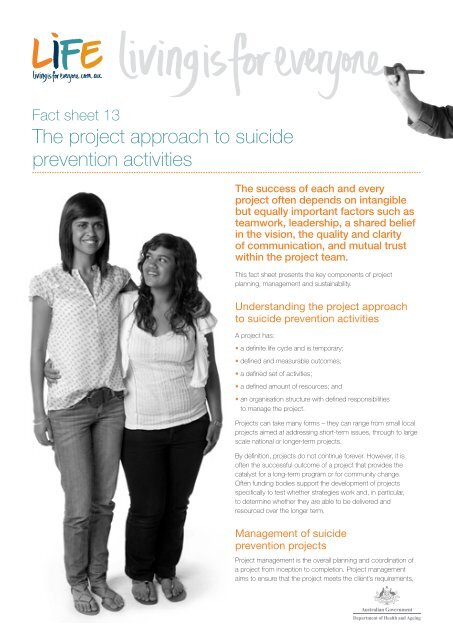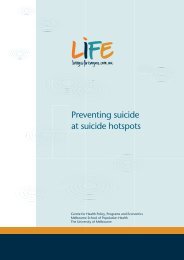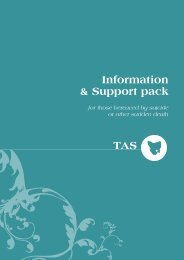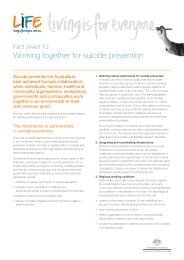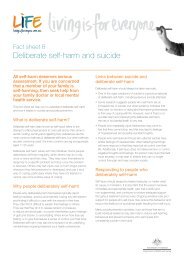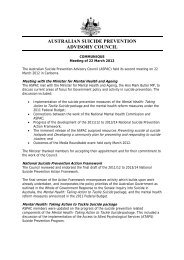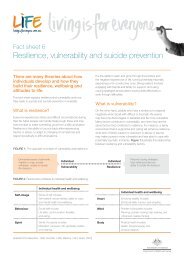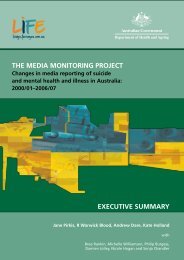The project approach to suicide prevention activities - Living is for ...
The project approach to suicide prevention activities - Living is for ...
The project approach to suicide prevention activities - Living is for ...
Create successful ePaper yourself
Turn your PDF publications into a flip-book with our unique Google optimized e-Paper software.
Fact sheet 13<br />
<strong>The</strong> <strong>project</strong> <strong>approach</strong> <strong>to</strong> <strong>suicide</strong><br />
<strong>prevention</strong> <strong>activities</strong><br />
<strong>The</strong> success of each and every<br />
<strong>project</strong> often depends on intangible<br />
but equally important fac<strong>to</strong>rs such as<br />
teamwork, leadership, a shared belief<br />
in the v<strong>is</strong>ion, the quality and clarity<br />
of communication, and mutual trust<br />
within the <strong>project</strong> team.<br />
Th<strong>is</strong> fact sheet presents the key components of <strong>project</strong><br />
planning, management and sustainability.<br />
Understanding the <strong>project</strong> <strong>approach</strong><br />
<strong>to</strong> <strong>suicide</strong> <strong>prevention</strong> <strong>activities</strong><br />
A <strong>project</strong> has:<br />
• a definite life cycle and <strong>is</strong> temporary;<br />
• defined and measurable outcomes;<br />
• a defined set of <strong>activities</strong>;<br />
• a defined amount of resources; and<br />
• an organ<strong>is</strong>ation structure with defined responsibilities<br />
<strong>to</strong> manage the <strong>project</strong>.<br />
Projects can take many <strong>for</strong>ms – they can range from small local<br />
<strong>project</strong>s aimed at addressing short-term <strong>is</strong>sues, through <strong>to</strong> large<br />
scale national or longer-term <strong>project</strong>s.<br />
By definition, <strong>project</strong>s do not continue <strong>for</strong>ever. However, it <strong>is</strong><br />
often the successful outcome of a <strong>project</strong> that provides the<br />
catalyst <strong>for</strong> a long-term program or <strong>for</strong> community change.<br />
Often funding bodies support the development of <strong>project</strong>s<br />
specifically <strong>to</strong> test whether strategies work and, in particular,<br />
<strong>to</strong> determine whether they are able <strong>to</strong> be delivered and<br />
resourced over the longer term.<br />
Management of <strong>suicide</strong><br />
<strong>prevention</strong> <strong>project</strong>s<br />
Project management <strong>is</strong> the overall planning and coordination of<br />
a <strong>project</strong> from inception <strong>to</strong> completion. Project management<br />
aims <strong>to</strong> ensure that the <strong>project</strong> meets the client’s requirements,
that the <strong>project</strong>’s objectives are achieved, and that completion<br />
occurs on time, within cost and <strong>to</strong> required quality standards.<br />
A <strong>project</strong> should have a nominated manager and management<br />
group <strong>to</strong> oversee the <strong>project</strong>. Th<strong>is</strong> <strong>is</strong> often called a Steering<br />
Committee or Project Management Committee and should<br />
compr<strong>is</strong>e at least a representative from the client/funding body<br />
and the consumer of the ‘product’.<br />
Suicide <strong>prevention</strong> <strong>project</strong>s can be managed by agencies or<br />
organ<strong>is</strong>ations, either solely or in partnership with others through<br />
a contractual arrangement. Sometimes an auspicing agency can<br />
act on behalf of a single or group of organ<strong>is</strong>ations which do not<br />
have the capacity or desire <strong>to</strong> manage a <strong>project</strong> in their own right.<br />
<strong>The</strong> auspicing agency receives the funding and has responsibility<br />
<strong>for</strong> the overall accountability of the per<strong>for</strong>mance of the <strong>project</strong>,<br />
including delivery of each component of the <strong>project</strong> and the<br />
expenditure of funds. Effective auspicing organ<strong>is</strong>ations should<br />
have in place sound governance structures and processes,<br />
a strong track record of transparent accountability <strong>to</strong> their<br />
members and funding bodies, effective contractual arrangements<br />
(eg MOU) with the other organ<strong>is</strong>ations, a commitment <strong>to</strong> adequate<br />
resourcing of admin<strong>is</strong>tration and organ<strong>is</strong>ational infrastructure<br />
<strong>for</strong> <strong>project</strong>s, professional and appropriately trained staff, and a<br />
reputation <strong>for</strong> excellence in responding <strong>to</strong> identified needs or<br />
gaps in market places.<br />
Essential components of <strong>suicide</strong><br />
<strong>prevention</strong> <strong>project</strong>s<br />
It <strong>is</strong> helpful <strong>to</strong> think of a <strong>project</strong> in terms of six main components:<br />
1. Project conceptual<strong>is</strong>ation/initiation – the rationale <strong>for</strong> the<br />
<strong>project</strong> and expected <strong>project</strong> outcomes. Th<strong>is</strong> <strong>is</strong> defined by the<br />
client and the planned outcomes will guide the <strong>project</strong> evaluation.<br />
2. Project planning – scheduling work <strong>to</strong> produce the required<br />
product (outputs and outcomes). A <strong>project</strong> plan <strong>is</strong> a road map<br />
that describes both the journey and the destination. It provides<br />
high level in<strong>for</strong>mation on what the <strong>project</strong> will achieve, how it will<br />
achieve it, how much it will cost, how long it will take and any<br />
hazards <strong>to</strong> look out <strong>for</strong> on the way. <strong>The</strong> plan <strong>for</strong>ms the bas<strong>is</strong> <strong>for</strong><br />
other plans and reports that may be required <strong>for</strong> the <strong>project</strong>, such<br />
as detailed work plans, r<strong>is</strong>k management plan, communication<br />
plan, <strong>project</strong> budget, progress and final reports. <strong>The</strong> main feature<br />
of the <strong>project</strong> plan <strong>is</strong> that it should be achievable.<br />
<strong>The</strong> <strong>project</strong> plan should include the following in<strong>for</strong>mation:<br />
• what (the planned <strong>project</strong> products and outcomes)<br />
• how and when (<strong>project</strong> <strong>activities</strong> according <strong>to</strong> the required<br />
sequencing of <strong>activities</strong>)<br />
• by whom (resources required)<br />
• costs<br />
• any external influences on the <strong>project</strong>; and<br />
• stages against which <strong>project</strong> progress will be moni<strong>to</strong>red.<br />
<strong>The</strong>re are many commercial <strong>project</strong> planning products that are<br />
commonly used <strong>to</strong> ass<strong>is</strong>t in efficient <strong>project</strong> planning and moni<strong>to</strong>ring.<br />
3. Product delivery – undertaking all the <strong>project</strong> work <strong>to</strong><br />
produce the outcomes. It will usually be split in<strong>to</strong> defined<br />
stages with each one having its own plan. <strong>The</strong> outcome must<br />
meet the quality standards defined at the beginning of the<br />
<strong>project</strong> by the client.<br />
4. Project completion – achieving <strong>project</strong> deliverables and<br />
handing over the results <strong>to</strong> the client. In <strong>suicide</strong> <strong>prevention</strong><br />
<strong>project</strong>s th<strong>is</strong> <strong>is</strong> often in the <strong>for</strong>m of a final report which<br />
documents measurable <strong>project</strong> outcomes or it can be a set<br />
of <strong>suicide</strong> <strong>prevention</strong> materials or a strategy.<br />
5. Project evaluation – <strong>is</strong> about making judgements of the<br />
degree <strong>to</strong> which the <strong>project</strong> has achieved its aims, the<br />
effectiveness with which it has been run, and/or the value<strong>for</strong>-money<br />
of the <strong>project</strong> achievements. Th<strong>is</strong> means making<br />
in<strong>for</strong>med and evidence-based judgements about how well<br />
the <strong>project</strong>’s objectives have been achieved, whether the key<br />
stakeholders have been sat<strong>is</strong>fied and how well the <strong>project</strong> has<br />
been managed. Funding bodies often provide an evaluation<br />
framework, and funding will usually be conditional on <strong>project</strong>s<br />
being assessed against that framework.<br />
6.Product sustainability – consideration of how the <strong>project</strong><br />
outcomes can be sustained in the longer term and the<br />
changes required <strong>to</strong> achieve th<strong>is</strong>. <strong>The</strong> <strong>project</strong> evaluation<br />
<strong>is</strong> critical <strong>to</strong> determining sustainability. A key strategy <strong>to</strong><br />
embed sustainability <strong>is</strong> <strong>to</strong> ensure that the learnings and<br />
successes of <strong>project</strong>s are shared within the local community.<br />
Ra<strong>is</strong>ing awareness of the <strong>project</strong> with key stakeholders and<br />
the broader community contributes <strong>to</strong> a shared sense of<br />
ownership and commitment.<br />
Community engagement with <strong>suicide</strong><br />
<strong>prevention</strong> <strong>project</strong>s<br />
<strong>The</strong> following checkl<strong>is</strong>t provides a useful l<strong>is</strong>t <strong>for</strong> determining<br />
how well-equipped individuals, groups and organ<strong>is</strong>ations within<br />
a community are <strong>to</strong> begin <strong>project</strong> planning and implementation.<br />
Community readiness checkl<strong>is</strong>t<br />
• Community leaders, men<strong>to</strong>rs and champions <strong>to</strong> support<br />
<strong>suicide</strong> <strong>prevention</strong> <strong>activities</strong> have been identified and coopted.<br />
• Community needs, h<strong>is</strong><strong>to</strong>ry and <strong>is</strong>sues in relation <strong>to</strong> <strong>suicide</strong><br />
<strong>prevention</strong> are well unders<strong>to</strong>od.<br />
• Participation from a diverse range of groups has been arranged<br />
and guaranteed.<br />
• <strong>The</strong>re <strong>is</strong> agreement on shared v<strong>is</strong>ion, goals and dec<strong>is</strong>ionmaking<br />
processes <strong>for</strong> the work.<br />
• <strong>The</strong>re <strong>is</strong> agreement on how ex<strong>is</strong>ting resources within the<br />
community will be mobil<strong>is</strong>ed and used.
Successful <strong>project</strong>s<br />
• <strong>The</strong>re are ex<strong>is</strong>ting networks <strong>to</strong> support the <strong>project</strong> or there <strong>is</strong><br />
agreement from a range of relevant community organ<strong>is</strong>ations<br />
<strong>to</strong> work <strong>to</strong>gether <strong>to</strong> support the <strong>project</strong>.<br />
• <strong>The</strong>re are sufficient resources (financial and human)<br />
<strong>to</strong> support the <strong>project</strong>.<br />
• <strong>The</strong> ex<strong>is</strong>ting knowledge and skills in relation <strong>to</strong> <strong>suicide</strong><br />
<strong>prevention</strong> in the community have been well researched<br />
and defined.<br />
Maintaining community partnerships throughout a <strong>project</strong> <strong>is</strong> an<br />
essential ingredient <strong>to</strong> success and requires careful planning and<br />
management. <strong>The</strong>re are several ways <strong>to</strong> involve <strong>project</strong> partners:<br />
• Special<strong>is</strong>t adv<strong>is</strong>ors can be individuals or a group who provide<br />
expert advice and guidance <strong>to</strong> a <strong>project</strong> on an as needs bas<strong>is</strong>.<br />
• Project steering committees are a way of involving a range<br />
of <strong>project</strong> partners, and can <strong>for</strong>m a link between the <strong>project</strong><br />
and the broader community. <strong>The</strong>y are typically made up of<br />
people with complementary skills and knowledge relevant <strong>to</strong><br />
the <strong>project</strong>’s goal and the membership should be kept <strong>to</strong> a<br />
workable number. Steering committees function best when<br />
they operate under agreed terms of reference that describe<br />
their role and operational procedures.<br />
• Formal partnership agreements are useful <strong>for</strong> <strong>project</strong>s that<br />
have shared operational and/or funding arrangements.<br />
Formal agreements can range from a negotiated legal<br />
agreement (usually drawn up by a solici<strong>to</strong>r) <strong>to</strong> memoranda<br />
of understanding detailing the allocation of responsibilities,<br />
accountability requirements, and other terms specific <strong>to</strong> the<br />
purpose of the <strong>project</strong>. Formal agreements often include a<br />
section dealing with conflict resolution.<br />
For a <strong>project</strong> <strong>to</strong> succeed the following must be present:<br />
• Effective communication between team members, between<br />
the <strong>project</strong> team and stakeholders, between the <strong>project</strong><br />
manager and the client;<br />
• A clear definition of the <strong>project</strong> so that everyone involved in it<br />
understands their role and responsibilities in achieving <strong>project</strong><br />
outcomes. Everyone must be reading from the same book,<br />
even if it changes during the <strong>project</strong>;<br />
• A detailed workplan that lays out key miles<strong>to</strong>nes and the<br />
deliverables attached <strong>to</strong> each one, allocation of resources<br />
including responsibilities of individual team members,<br />
timeframes <strong>for</strong> completion of tasks in terms of duration<br />
of the task and the actual time required <strong>to</strong> complete it;<br />
• A focus on quality of products and processes of the <strong>project</strong>.<br />
Th<strong>is</strong> includes defining quality standards at the outset,<br />
developing a quality plan and moni<strong>to</strong>ring achievement of it;<br />
• Accurate r<strong>is</strong>k assessment with identified r<strong>is</strong>k management<br />
strategies; and<br />
• Managing time so that all <strong>activities</strong> are defined within a<br />
timeframe, standards are set <strong>for</strong> achievement and<br />
completion of <strong>activities</strong>.<br />
Source: Project Management Skills Kit 2004, NSW Department<br />
of Education and Training.
Projects that fail<br />
Projects that fail have common features, which include:<br />
• Leaving out key people. To progress with a <strong>project</strong>, no matter<br />
how straight <strong>for</strong>ward it <strong>is</strong>, and inadvertently or deliberately omit<br />
a key stakeholder or someone with key expert<strong>is</strong>e <strong>is</strong> asking <strong>for</strong><br />
trouble and results in time delays.<br />
• Not meeting specifications. <strong>The</strong> client’s needs will define<br />
the specifications of the <strong>project</strong>. If they are not met it usually<br />
means having <strong>to</strong> redo work and waste valuable resources.<br />
• Taking your eye off the ball. It <strong>is</strong> easy <strong>to</strong> be d<strong>is</strong>tracted by other<br />
work or by the work of someone else. A detailed individual work<br />
plan that <strong>is</strong> carefully followed protects against th<strong>is</strong> happening.<br />
• Not tracking agreed changes in writing. Projects often fail because<br />
conversations about changes <strong>to</strong> <strong>project</strong> components have<br />
occurred between key <strong>project</strong> stakeholders without recording<br />
them. Keeping a record of agreed changes <strong>is</strong> crucial <strong>to</strong> <strong>project</strong>s.<br />
• Changing <strong>project</strong> scope. When the <strong>project</strong> methodology,<br />
resourcing and team allocations are determined it <strong>is</strong> according<br />
<strong>to</strong> the agreed scope of the <strong>project</strong>. If the scope changes,<br />
it will have resultant effects on the <strong>project</strong> <strong>activities</strong> and would<br />
usually mean renegotiating the <strong>project</strong> arrangements.<br />
• Key personnel leaving. During the lifecycle of a <strong>project</strong>,<br />
no matter how long it <strong>is</strong> expected <strong>to</strong> run, key people may<br />
leave and th<strong>is</strong> needs <strong>to</strong> be managed.<br />
• If there <strong>is</strong> change in the personnel of the sponsor, confusion<br />
can ar<strong>is</strong>e. Th<strong>is</strong> needs <strong>to</strong> be rapidly confronted <strong>to</strong> ensure no<br />
changes <strong>to</strong> agreed <strong>project</strong> arrangements. If th<strong>is</strong> happens late<br />
in a <strong>project</strong> it could spell d<strong>is</strong>aster.<br />
More in<strong>for</strong>mation<br />
• Commonwealth Department of Families, Housing,<br />
Community Services and Indigenous Affairs – Good Practices<br />
and Pitfalls in Community based Capacity Building and Early<br />
Intervention Projects <strong>to</strong>olkit available at www.facsia.gov.au<br />
• Commonwealth Department of Health and Ageing –<br />
Building Healthy Communities A Guide <strong>for</strong> Community Projects:<br />
www.health.gov.au<br />
• Community Builders NSW – help <strong>for</strong> NSW communities across<br />
the state share ideas on how <strong>to</strong> enhance and strengthen their<br />
community: www.communitybuilders.nsw.gov.au<br />
• <strong>Living</strong> Is For Everyone (LIFE) – A Framework <strong>for</strong> Prevention<br />
of Suicide in Australia (2007). Commonwealth Department<br />
of Health and Ageing: Canberra.<br />
• <strong>Living</strong> Is For Everyone (LIFE) – Research and Evidence in<br />
Suicide Prevention (2007). Commonwealth Department<br />
of Health and Ageing: Canberra.<br />
• Free Management Library – resources regarding the leadership<br />
and management of yourself, other individuals, groups and<br />
organizations: www.managementhelp.org<br />
• Mental health & well being – in<strong>for</strong>mation on the Australian<br />
Government’s role and contributions <strong>to</strong> mental health re<strong>for</strong>m<br />
<strong>activities</strong> in Australia: www.mentalhealth.gov.au<br />
• Mental Health Promotion Toolkit – A practical resources <strong>for</strong><br />
community initiatives (Canadian Mental Health Association):<br />
www.cmha.ca<br />
• Our Community – A knowledge bank <strong>for</strong> community groups:<br />
www.ourcommunity.com.au<br />
• Commonwealth Department of Health and Ageing – Suicide and<br />
mental illness in the media: a Mindframe resource <strong>for</strong> the mental<br />
health sec<strong>to</strong>r: www.mindframe-media.info<br />
<strong>The</strong> Australian Government Department of Health and Ageing has financially supported the production<br />
of th<strong>is</strong> document. While every ef<strong>for</strong>t has been made <strong>to</strong> ensure that the in<strong>for</strong>mation contained <strong>is</strong> accurate<br />
and up-<strong>to</strong>-date at the time of publication, the department does not accept responsibility <strong>for</strong> any errors,<br />
om<strong>is</strong>sions or inaccuracies. © Commonwealth of Australia 2007. Th<strong>is</strong> work <strong>is</strong> copyright. Apart from any<br />
use as permitted under the Copyright Act 1968, no part may be reproduced by any process without prior<br />
written perm<strong>is</strong>sion from the Commonwealth. Requests and inquiries concerning reproduction and rights<br />
should be addressed <strong>to</strong> the Commonwealth Copyright Admin<strong>is</strong>tration, At<strong>to</strong>rney-General’s Department,<br />
Robert Garran Offices, National Circuit, Bar<strong>to</strong>n ACT 2600 or posted at http://www.ag.gov.au/cca


